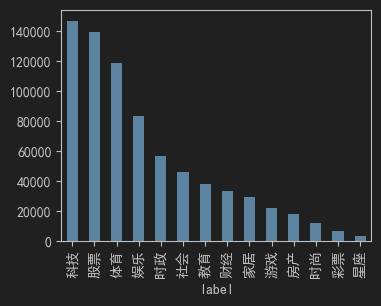Pandas
本文记录 Pandas 的用法。
Pandas 的基本数据结构由 DataFrame 和 Series 组成,这也是 Pandas 的核心所在。
DataFrame
二维表格型数据结构,带行索引和列标签,是 Pandas 的核心对象。
import pandas as pd
df = pd . DataFrame ({
"int_col" : [ 1 , 2 , 3 , 4 , 5 ],
"text_col" : [ "alpha" , "beta" , "gamma" , "delta" , "epsilon" ],
"float_col" : [ 0.0 , 0.25 , 0.5 , 0.75 , 1.0 ]
})
df.info()查看数据表基本信息(行数、列数、非空值、数据类型):
import pandas as pd
int_values = [ 1 , 2 , 3 , 4 , 5 ]
text_values = [ 'alpha' , 'beta' , 'gamma' , 'delta' , 'epsilon' ]
float_values = [ 0.0 , 0.25 , 0.5 , 0.75 , 1.0 ]
df = pd . DataFrame ({
"int_col" : int_values ,
"text_col" : text_values ,
"float_col" : float_values
})
df . info ()
""" 输出
<class 'pandas.core.frame.DataFrame'>
RangeIndex: 5 entries, 0 to 4
Data columns (total 3 columns):
# Column Non-Null Count Dtype
--- ------ -------------- -----
0 int_col 5 non-null int64
1 text_col 5 non-null object
2 float_col 5 non-null float64
dtypes: float64(1), int64(1), object(1)
memory usage: 252.0+ bytes
"""
df.describe()查看数值型与分类型列的统计特征:
import pandas as pd
int_values = [ 1 , 2 , 3 , 4 , 5 ]
text_values = [ 'alpha' , 'beta' , 'gamma' , 'delta' , 'epsilon' ]
float_values = [ 0.0 , 0.25 , 0.5 , 0.75 , 1.0 ]
df = pd . DataFrame ({
"int_col" : int_values ,
"text_col" : text_values ,
"float_col" : float_values
})
df . describe ( include = 'all' )
""" 输出
int_col text_col float_col
count 5.000000 5 5.000000
unique NaN 5 NaN
top NaN alpha NaN
freq NaN 1 NaN
mean 3.000000 NaN 0.500000
std 1.581139 NaN 0.395285
min 1.000000 NaN 0.000000
25% 2.000000 NaN 0.250000
50% 3.000000 NaN 0.500000
75% 4.000000 NaN 0.750000
max 5.000000 NaN 1.000000
"""
Series
一维带标签数组,常用来表示单列。
s = pd . Series ([ 10 , 20 , 30 ], index = [ "a" , "b" , "c" ])
print ( s [ "a" ]) # 10
se.plot()绘制直方图:
plt . figure ( figsize = ( 4 , 3 ))
train [ 'label' ] . value_counts () . plot ( kind = 'bar' )
plt . show ()
文件操作
读:
train_df = pd . read_table ( "train.txt" , sep = " \t " , header = None )
dev_df = pd . read_table ( "dev.txt" , sep = " \t " , header = None )
test_df = pd . read_table ( "test.txt" , sep = " \t " , header = None )
header 参数:表头所在行。例如 header=0。当 header=None 时表示没有表头或不加载表头;
sep 参数:即 separate,表示分隔符。
添加列名:
train_df . columns = [ "feature" , "label" ]
dev_df . columns = [ "feature" , "label" ]
test_df . columns = [ "feature" ]
写:
train_df . to_csv ( "train.csv" , sep = " \t " , index = False )
dev_df . to_csv ( "dev.csv" , sep = " \t " , index = False )
test_df . to_csv ( "test.csv" , sep = " \t " , index = False )
数据处理
索引
分以下四种:
loc:行号、列标签,能切片;iloc:行号、列号,能切片;at:单个元素(行号 + 列标签),更快;iat:单个元素(行号 + 列号),更快。
如下示例:
locilocatiat
# 准备数据
df = pd . DataFrame ({
"name" : [ "Alice" , "Bob" , "Charlie" ],
"age" : [ 23 , 30 , 27 ],
"score" : [ 85 , 92 , 78 ]
})
# 单个元素
print ( df . loc [ 0 , "age" ])
"""
23
"""
# 多行多列
print ( df . loc [ 0 : 1 , [ "name" , "score" ]])
"""
name score
0 Alice 85
1 Bob 92
"""
# 准备数据
df = pd . DataFrame ({
"name" : [ "Alice" , "Bob" , "Charlie" ],
"age" : [ 23 , 30 , 27 ],
"score" : [ 85 , 92 , 78 ]
})
# 单个元素
print ( df . iloc [ 0 , 1 ])
"""
23
"""
# 多行多列
print ( df . iloc [ 0 : 2 , [ 0 , 2 ]])
"""
name score
0 Alice 85
1 Bob 92
"""
# 准备数据
df = pd . DataFrame ({
"name" : [ "Alice" , "Bob" , "Charlie" ],
"age" : [ 23 , 30 , 27 ],
"score" : [ 85 , 92 , 78 ]
})
# 单个元素(比 loc 更快)
print ( df . at [ 0 , "age" ])
"""
23
"""
# 准备数据
df = pd . DataFrame ({
"name" : [ "Alice" , "Bob" , "Charlie" ],
"age" : [ 23 , 30 , 27 ],
"score" : [ 85 , 92 , 78 ]
})
# 单个元素(比 iloc 更快)
print ( df . iat [ 0 , 1 ])
"""
23
"""
拷贝
如下示例:
test_copy = test_df . copy ( deep = True )
添加新列
如下示例:
test_copy [ "label" ] = "unknown"
布尔索引
如下示例:
# 统计某个条件的数量
unknown_count = ( test_copy [ "label" ] == "unknown" ) . sum ()
# 筛选数据
filtered_df = test_copy [ test_copy [ "label" ] != "unknown" ]
统计转换
按行合并
merged_df = pd . concat ([ train_df , test_copy ], axis = 0 )
按行遍历
这个问题很有代表性:Pandas 按行遍历是很多人第一直觉,但其实在性能上是“不得已而为之”的手段,因为 Pandas 更推荐向量化运算或 apply。完整地说,常见写法有以下几类:
iterrows(),最常见的写法(index, Series),使用起来直观,但慢,尤其是大数据量:
for idx , row in df . iterrows ():
print ( idx , row [ "int_col" ], row [ "text_col" ])
缺点:返回的是 Series,数据类型可能被强制转换(int → float)。
itertuples(),更快的方式namedtuple,访问列时用属性(点操作符),速度比 iterrows() 快得多:
for row in df . itertuples ( index = True , name = "Row" ):
print ( row . Index , row . int_col , row . text_col )
注意:默认 index=True,会把索引当作第一个字段;name=None 时返回普通 tuple,更快但可读性差。
apply(),用函数“按行处理”apply(func, axis=1) 可以让你写一个函数处理每一行,返回新的 Series 或 DataFrame:
df [ "new_col" ] = df . apply ( lambda row : row [ "a" ] + row [ "b" ], axis = 1 )
适合“逐行生成新列”的情况。
向量化(推荐优先) 。很多场景根本不需要逐行遍历,直接用列运算更高效:
df [ "new_col" ] = df [ "a" ] + df [ "b" ]
这其实等价于上面 apply 的效果,但性能要好得多。
2025年11月16日
2025年11月16日
GitHub
